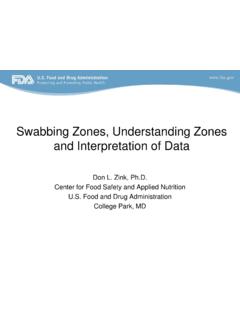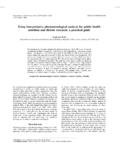Transcription of Definitions of indicators for child anthropometry - who.int
1 nutrition Landscape Information System (NLIS). Country Profile indicators interpretation guide nutrition Landscape Information System (NLIS). COUNTRY PROFILE. indicators . interpretation guide WHO Library Cataloguing-in-Publication Data: nutrition Landscape Information System (NLIS) country profile indicators : interpretation guide . status. disorders. nutrition disorders. collection. status indicators . Health Organization. ISBN 978 92 4 159995 5 (NLM classification: QU 145). World Health Organization 2010. All rights reserved. Publications of the World Health Organization can be obtained from WHO. Press, World Health Organization, 20 Avenue Appia, 1211 Geneva 27, Switzerland (tel.: +41. 22 791 3264; fax: +41 22 791 4857; e-mail: Requests for permission to reproduce or translate WHO publications whether for sale or for noncommercial distribution . should be addressed to WHO Press, at the above address (fax: +41 22 791 4806; e-mail: The designations employed and the presentation of the material in this publication do not imply the expression of any opinion whatsoever on the part of the World Health Organization concerning the legal status of any country, territory, city or area or of its authorities, or concerning the delimitation of its frontiers or boundaries.))
2 Dotted lines on maps represent approximate border lines for which there may not yet be full agreement. The mention of specific companies or of certain manufacturers' products does not imply that they are endorsed or recommended by the World Health Organization in preference to others of a similar nature that are not mentioned. Errors and omissions excepted, the names of proprietary products are distinguished by initial capital letters. All reasonable precautions have been taken by the World Health Organization to verify the information contained in this publication. However, the published material is being distributed without warranty of any kind, either expressed or implied. The responsibility for the interpretation and use of the material lies with the reader. In no event shall the World Health Organization be liable for damages arising from its use. Printed by the WHO Document Production Services, Geneva, Switzerland Acknowledgement The development of the nutrition Landscape Information System (NLIS) was one of the three parallel activities of the Landscape Analysis project; the second being the development of country typologies for "readiness" to accelerate action through the desk review; and the third, the implementation of in-depth country assessments.
3 The development of the NLIS aimed at raising awareness of, and concern about, the Country Profiles among country policy-makers and other stakeholders including donors. Bringing various existing nutrition -related databases together inside WHO and also those of other partner agencies to develop NLIS should help nutrition action as a whole to be presented in a more comprehensive way. This is a living document which may be updated based on new research or feedback from users. Special acknowledgement is made to the Bill & Melinda Gates Foundation for supporting the implementation of the Landscape Analysis on Countries'. Readiness to Accelerate Action in nutrition . Deep appreciations are expressed first of all to the Governments and the intersectoral/interagency country teams in respective countries who have undertaken the Landscape Analysis country assessments and also those who have shown the great interest in undertaking these country assessments, and also to the members of the Partner Agency Group, including UN agencies (in particular FAO, UNICEF, WFP, World Bank), bilateral agencies, NGOs (in particular Helen Keller International and GAIN), research and academic institutions such as Medical Research Council in South Africa as well as a number of collaborating experts who had supported and guided in various stages of the preparations and implementation of the Landscape Analysis.
4 CONTENTS: Preface Malnutrition in Underweight, stunting, wasting and overweight .. 1. Low birth 2. Malnutrition in women ..3. Moderate and severe thinness, underweight, overweight, obesity .. 3. Vitamin and mineral 4. Vitamin A deficiency .. 6. Iodine deficiency .. 7. Health services ..8. Births attended by skilled health 8. Children aged 6 59 months receiving vitamin A supplements .. 9. Children aged 1 year immunized against 10. Children with diarrhoea who receiving zinc .. 10. Improved sanitation facilities and drinking-water 11. Women receiving iron and folate supplements during pregnancy .. 12. Food security ..13. Population living on less than US$ 1 per 13. Population with less than the minimum dietary energy 14. Households consuming adequately iodized salt ( 15 parts per million) .. 15. Caring Infant and young child 16. Children with diarrhoea receiving oral rehydration therapy and continued feeding .. 19. Women aged 15 19 years who are mothers or are pregnant with their first 19.
5 Health expenditure .. 20. nutrition component of the United Nations Development Assistance 20. nutrition component of poverty reduction strategy 23. nutrition governance .. 24. Monitoring and enforcing the International Code on Marketing of Breast-milk Substitutes .. 25. Maternity leave .. 26. Degree training in nutrition and nutrition in medical curricula .. 27. Density of nutrition 27. Density of nurses and midwives .. 27. Gross domestic product per capita and annual growth 28. Official development assistance .. 29. Low-income food-deficit countries (LIFDC) .. 29. Meta- indicators ..30. Women in national parliaments .. 30. Averaged aggregate governance 31. Gender equality .. 33. Global Hunger 35. Human development 36. Retention and school drop-out .. 37. Under-five mortality .. 37. Female education 38. Preface The nutrition Landscape Information System (NLIS) was developed as part of the Landscape Analysis on Readiness to Accelerate Action in nutrition . While many individual sources of publicly-available data exist, it can be a challenge to identify, collect and organize those data systematically from various sources as well as to monitor any updates as new data become available.
6 Therefore, the main aims of NLIS are to: Bring together nutrition -related indicators in standardized form. NLIS ensures access to a variety of nutrition indicators as well as health, food, care, development and economic indicators related to nutrition in a single easy-to-access and user-friendly location. Track changes over time and monitor progress. This comprehensive data collection system includes data from multiple time points, including historical as well as most- recent data, and has the capacity to incorporate data from future time points as these become available. Generate easy-to-interpret Country Profiles. The concise Country Profiles include selected nutrition and related indicators and visual presentations provide an easy-to- understand snapshot of key nutrition , health, and development indicators at national level. The Country Profiles are a powerful advocacy tool for communicating with policy makers who might not have a health or nutrition background.
7 NLIS currently draws publicly-available data from the World Health Organization (WHO), the United Nations Children's Fund (UNICEF), the UN Statistics Division, the UN Development Programme (UNDP), the Food and Agriculture Organization of the UN (FAO), Demographic and Health Surveys (DHS), the World Bank, the International Food Policy Research Institute (IFPRI), and the International Labour Organization (ILO). These data from external sources are being combined with data from the WHO Global nutrition Databases which are brought together dynamically. Through this NLIS has achieved: Efficiency: Improved access to comprehensive nutrition information across multiple sources Integration: Combined information leading to more integrated approaches to nutrition interventions Timeliness: Linked dynamically to WHO Global nutrition Databases Accessibility: Easy access to quality information leading to more informed decision-making Comprehensiveness: Most indicators available for all countries This interpretation guide provides information on all indicators included in the Country Profile.
8 For each indicator, the following aspects are addressed: 1. What does this indicator tell us 2. How is it defined 3. What are consequences/implications, which includes cut-off values for public health significance where these have been established 4. Source and further reading Malnutrition in children Underweight, stunting, wasting and overweight What do these indicators tell us? These indicators are used to measure nutritional imbalance resulting in undernutrition (assessed from underweight, wasting and stunting) and overweight. child growth is internationally recognized as an important indicator of nutritional status and health in populations. The percentage of children with a low height for age (stunting) reflects the cumulative effects of undernutrition and infections since and even before birth. This measure can therefore be interpreted as an indication of poor environmental conditions or long-term restriction of a child 's growth potential. The percentage of children who have low weight for age (underweight).
9 Can reflect wasting' ( low weight for height), indicating acute weight loss, stunting', or both. Thus, 'underweight' is a composite indicator and may therefore be difficult to interpret. How are they defined? Underweight: weight for age < 2 standard deviations (SD) of the WHO child Growth Standards median Stunting: height for age < 2 SD of the WHO child Growth Standards median Wasting: weight for height < 2 SD of the WHO child Growth Standards median Overweight: weight for height > +2 SD of the WHO child Growth Standards median What are the consequences and implications? Underweight: As weight is easy to measure, this is the indicator for which most data have been collected in the past. Evidence has shown that the mortality risk of children who are even mildly underweight is increased, and severely underweight children are at even greater risk. Stunting: Children who suffer from growth retardation as a result of poor diets or recurrent infections tend to be at greater risk for illness and death.
10 Stunting is the result of long-term nutritional deprivation and often results in delayed mental development, poor school performance and reduced intellectual capacity. This in turn affects economic productivity at national level. Women of short stature are at greater risk for obstetric complications because of a smaller pelvis. Small women are at greater risk of delivering an infant with low birth weight, contributing to the intergenerational cycle of malnutrition, as infants of low birth weight or retarded intrauterine growth tend be smaller as adults. Wasting: Wasting in children is a symptom of acute undernutrition, usually as a consequence of insufficient food intake or a high incidence of infectious diseases, especially diarrhoea. Wasting in turn impairs the functioning of the immune system and can lead to increased severity and duration of and susceptibility to infectious diseases and an increased risk for death. Overweight: Childhood obesity is associated with a higher probability of obesity in adulthood, which can lead to a variety of disabilities and diseases, such as diabetes and cardiovascular diseases.















